Tours, Attractions and Things to Do in Nagoya
Are you heading to Nagoya and wondering what you can't miss? Here's Advantour's go-to travel guide to a perfect vacation filled with charming parks, exciting manufacturing, and historic sites, including a castle—a replica of the 16th-century palace destroyed during World War II air raids.
Amidst the bustling metropolises of Tokyo and Kyoto, Nagoya emerges as a prominent city in Japan's Chubu Region (Central Region), overlooking the Pacific Coast. Its strategic location makes it an ideal gateway for travelers eager to uncover the hidden treasures of the Hokuriku Region, including Kanazawa and Takayama. Whether you seek a day trip or an extended sojourn, Nagoya presents an array of attractions and experiences.
Furthermore, you will come to Nagoya for its delicious food scene, featuring several traditional dishes, like hitsumabushi, miso katsu, and doteni, that will catch any tourist off guard. Although the city doesn’t have the sheer number of modern attractions and nightlife that Tokyo and Osaka offer, there’s still a lot of things to do in Nagoya.
Why visit Nagoya?

Nagoya is the third largest city in Japan and a major port and transportation hub in the Land of the Rising Sun. That's the first thing that comes to mind when you think of Nagoya. Secondly, it is an industrial hub, which you can witness at Toyota-related museums and a railway park. Let’s look at each of them separately.
Nagoya Port
Nagoya Port lies south of the city's center. The local municipality has transformed the famous Garden Pier into a leisure district with a shopping mall, an aquarium, an amusement park, green spaces, and museums.
The Port of Nagoya Public Aquarium is one of Japan’s largest aquariums. It covers two buildings that house marine mammals like dolphins, beluga whales, and other ocean creatures across different Antarctic Ocean habitats. Visitors can watch feeding and training shows, including a dazzling dolphin show.
While down at the port area, a must-see spot is the Fuji Ice Breaker Ship, once in service from the 1960s to the 1980s. Today, it is an exhibit ship with a 53-meter observatory, a maritime museum, and a helicopter on the bow deck. In addition, an amusement park called Nagoya Port Sea Train Land, next to the aquarium, has the highest Ferris Wheel in the Chubu region, which can be an ideal attraction for those not afraid of heights. The bonus is a gorgeous city view.
Toyota Commemorative Museum of Industry and Technology
The city of Nagoya in Aichi Prefecture is often associated with the automobile manufacturer – Toyota. The museum provides an excellent opportunity to learn about the history of automotive manufacturing and see giant machines from the Taisho period (1912-1926) that still operate today. Interestingly, Toyota started out as a cotton manufacturing company.
Toyota Automobile Museum
This large museum is not only about the Toyota car history and displays, but it also showcases 140 vehicles from other brands worldwide. All the cars are organized based on their release year – from gasoline-powered automobiles to modern ones. The museum is worth a whole day’s visit, and between visiting different displays, guests can hop into a restaurant or café inside the building.
SCMaglev and Railway Park
SCMaglec and Railway Park, belonging to JR Central (Central Japan Railways), is a railway museum featuring historic trains, high-speed trains, and the latest magnetic levitating trains (maglev). Train simulators are increasingly popular activities among young children, allowing them to pretend to be conductors by opening and closing the doors.
Best Time to Visit Nagoya

Spring and autumn are the best seasons to visit Nagoya in terms of weather and diversity of events. The weather during these periods is moderate, and the air temperature is ideal for strolling through the city and gardens and participating in local festivals. Spring is remarkably graceful thanks to the blooming sakura, while Nagoya clads in a brown-green-yellow attire during the autumn foliage.
Summer in Nagoya is typically rainy, hot, and humid. The hottest month is August, with temperatures rising to 35°C (95°F) and above. However, July to October is best for those wishing to spend time on the beach, as the water stays warm during these months.
The coldest month in Nagoya is January, with an average temperature of 4.7°C (40°F). Unlike summer, winter is dry, with the sun shining 50% of the time.
History of Nagoya
During the Edo period (1603-1868), Nagoya's historical journey began with the construction of Nagoya Castle on the site of the former Oda Clan castle that belonged to the Owary Domain. Soon, it became an important trade and cultural center, thanks to its strategic routes.
During the late Edo period, Nagoya continued to expand, emerging as a hub for ceramics and other crafts. At the outset of the Meiji Period (1868-1912), the city focused on textile and automobile manufacturing.
Nagoya was heavily bombed and destroyed during World War II. Following the war, however, the city saw rapid restoration, developing into a key industrial hub in the country.
In the second half of the 20th century, Nagoya became a core city for the automobile industry. Toyota, Honda, and Mitsubishi are all headquartered here. The economy grew fast, making Nagoya one of Japan’s prominent industrial centers. Today, Nagoya is the third-largest metropolitan area with ultra-modern infrastructure, diverse tech companies, and cultural attractions. Like many locales in Japan, the city is a blend of old and new, perfectly marrying the glorious past with the latest technological advancements.
Historic Places to See in Nagoya

Tourists love spots where history flows through the streets like water in a river. Here’s a list of historic sites where you can experience the rich history of Nagoya.
Nagoya Castle
When talking about Nagoya's historic attractions, Nagoya Castle is the top icon. Originally built by Tokugawa Ieyasu in 1615, the castle was burned down during World War II but was restored in 1959, along with the golden shachihoko (tiger-headed dolphins or carp), the beloved symbol of Nagoya Castle.
Tokugawa Garden
The Tokugawa Garden is a haven for wildlife and a showcase of Japan’s blooming seasons. It was landscaped in 1695 as a retirement villa for one of the Tokugawa’s great feudal lords – shogun. The park area spans around 45,000 square meters in the center of Nagoya, near the Nagoya Castle and Tokugawa Art Museum. It is an ideal destination for autumn leaves viewing.
Atsuta Jingu
An ancient shrine, Atsuta Jingu, has a history of over 1,900 years. Dedicated to the revered Atsuta-no-Okami, it holds profound significance as it houses one of the Three Scared Treasures of Japan - the legendary Kusanagi Sword.
The shrine contains 4,000 relics, and its wonders don’t end there. In addition, it prides itself on the Atsuta Jingu Museum, where one can marvel at sacred utensils, furniture, and garments that whisper the tales of the past.
Kiyosu Castle
A picturesque scarlet bridge and Koi fish swimming in the river underneath lead up to Kiyosu Castle. As you enter the temple, you will encounter a beautiful Koi fish pond and rock and sand Zen Garden. Inside the castle, there is a small museum featuring samurai armor and swords. The top of the castle provides a great view of the surroundings. Plus, the structure is close to the Shinkansen tracks, allowing you to see bullet trains whizzing by.
Kiyosu Castle is a historic stronghold in the small town of Kiyosu. Oda Nobunaga entered it in 1555 and won the Battle of Okehazama in 1560, making the first stride towards unifying Japan. The current partial reconstruction occurred in 1989.
Top Attractions in Nagoya for Families

Parents visiting Japan with kids need to plan a holiday differently from those traveling without children. Is Nagoya child-friendly? The answer is YES! Scroll down to see the list of fun things to do for the little ones!
Legoland Japan
Both children, teenagers, and adults can all have a good time at the Nagoya Legoland – the amusement theme park. Many praise the Ninjago show held three times a day. And, of course, Lego fans will be blasted seeing the masterpieces of Lego in the amazing miniature city built from Lego bricks. There are many great rides for children. One of them, the submarine ride, is especially favored by kids.
Expo 2005 Commemorative Park
Guests on a long visit to Japan looking for a full-day family outing in Nagoya should put the Expo 2005 Commemorative Park on their radar. It’s a massive park with a variety of facilities that should be explored all within one day. The options for walking, biking, and hiking are abundant. Opened in 2022, Ghibli Park is the highlight of the area. On top of that, the Expo Park delights travelers with the Ferris Wheel, Japanese Tea Room, and food trucks that sell delicious food. To visit all the attractions at the park, get a premium ticket.
Nagoya City Science Museum
Children love to learn chemistry and physics when theory becomes real magic. Multiple exhibits at the Nagoya City Science Museum cater to interactive and educational activities that can keep your offspring engaged for a few hours. From tornado simulation and the -30°C experience to the electrical room and the captivating planetarium show, this museum is a must-visit for anyone interested in science and technology.
Higashiyama Zoo and Botanical Gardens
Higashiyama Zoo is another place – something for everyone, adults and kids alike. It is home to an array of 500 species, and it also includes a botanical garden and an amusement park. As a result, travelers can see so much that they would need more than one day to catch a glimpse of all the animals and plant exhibits in this expansive space. Perhaps the best animals to view are koalas. Seeing these slow creatures in action can be challenging because they sleep about 18-20 hours a day. But you can enjoy moving koalas at one o'clock as they get their lunch.
Port of Nagoya Public Aquarium
The aquarium spans 7,800 square meters and welcomes over 2,000 marine fish from 200 unique species from every corner of the world. Comers can gawk at the three-meter sharks, eels, piranhas, lobsters, starfish, and other invertebrate creatures. Moreover, the marine exhibit serves as a sanctuary for endangered animals.
Nagoya Destinations for Couples
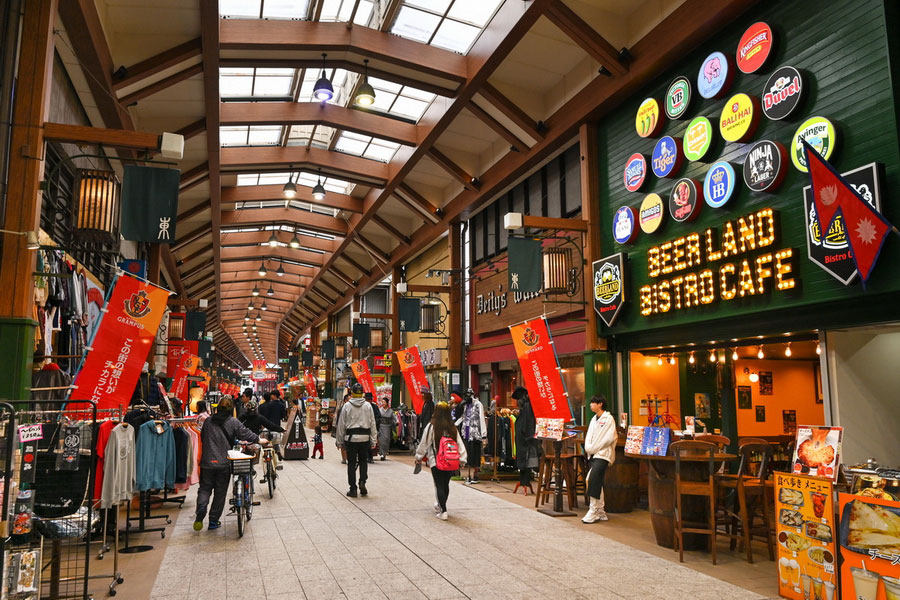
Traveling with your better half strengthens the connection while seizing unique moments as a couple. If you are heading to Nagoya and planning such an experience but don’t know where to go, these top attractions are perfect for you.
Osu Shopping Arcade
The Osu Shopping Arcade in central Nagoya is located next to the Buddhist temple, Osu Kannon. It is a lineup of covered alleys with over 400 shops selling virtually anything – fashion, shoes, bags, pharmacies, comics, antiques, and so much more. You can easily spend the whole day in the Osu shopping walkways, which are dotted with many restaurants and cute cafes.
Noritake Garden
Located on the former soil of the Norikate Factory, Noritake Garden is part of the complex related to ceramics. In addition to the Craft Center and Norikate Museum, the garden has cafes, restaurants, and a fountain plaza, allowing for a relaxing time amidst nature.
Nagoya TV Tower
Built in 1954, Nagoya TV Tower, or Chubu Electric Power Mirai Tower, is one of Japan's oldest radio towers. It's a beloved symbol of Nagoya and a national tangible cultural property. It gives a breathtaking view over the city and shines like a disco ball at night, so it's no wonder it was recently touted as “Thunder Tower”.
Higashiyama Sky Tower
Constructed in 1989, in reference to the 100th anniversary of Nagoya City’s incorporation, the 134-meter Higashiyama Sky Tower provides a 360-degree view of the zoo, the Botanical Garden, and the volcanic Mt. Ontake on a clear day. The tower houses a classy restaurant and a gift shop.
Midland Square
Towering 47 stories in the Meieki district of Nakamura-ku, the building is the tallest in Nagoya and Aichi Prefecture. Midland Square is an open-air observatory deck atop 274 meters. All-glass walls offer a panoramic view of the city and key landmarks like the JR Central Towers, Nagoya Port, and Nagoya Castle.
Best Nature Attractions in Nagoya
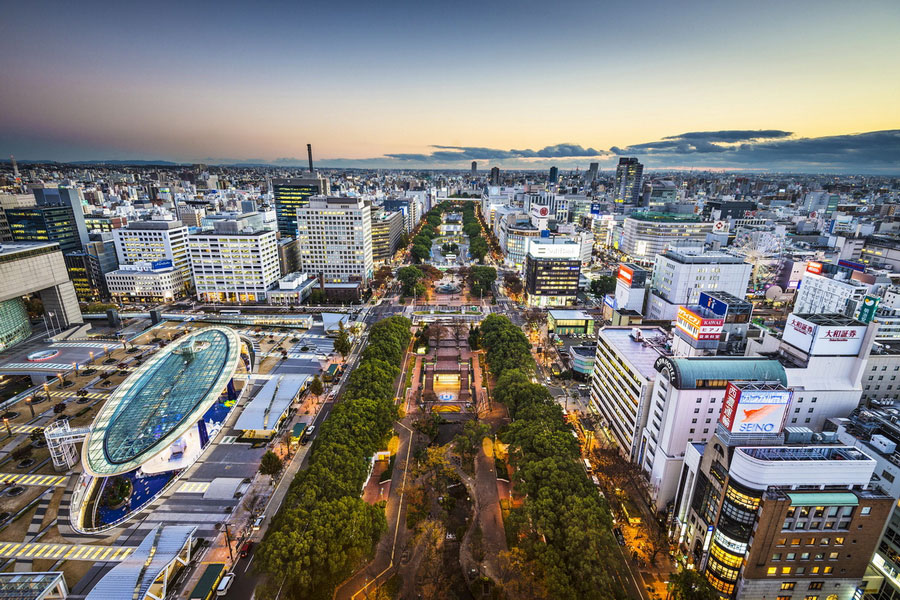
Japanese cities are increasingly modern, with soaring skyscrapers and other glass-and-steel superstructures. Yet the Japanese love for nature translates into vast and small green spaces that can be found in every metropolitan area, providing an escape from the bustling urban landscape. Read our Japanese travel guide to discover some of the finest nature-centric attractions in Nagoya.
Tsuruma Park
Tsuruma Park was the first park landscaped in Nagoya in 1909. It combines both Japanese and Western gardening styles. The Western-style section has a rose garden and flower beds around a fountain, while the Japanese garden boasts 1,400 sakura trees, including irises, azaleas, and more, making the park vivid in spring.
Hisaya-odori Park
If you are looking for a calm and resting refuge in Nagoya downtown, Hisaya-odori Park is a must-go. It spreads over 2 km from Wakamiya Odori at the southern end to Sotobori-dori at the northern end. Hisaya’s main attraction is the Nagoya TV Tower. Here, adventurers can stroll, enjoy open-air concerts, shop at the Oasis 21 Mall, and indulge in delicious food at one of the many restaurants.
Yamazaki River is stunning during the sakura season. It is equipped with walking paths, drinking fountains, benches, and accessible spots, letting sightseers get close to the river. The riverbanks are brimmed with approximately 600 cherry trees, which bloom in full glory along the 2.8 km stretch on both sides. Cherry viewing is glowing at night when the Yamazaki River is lit up with floodlights.
Shirototi Garden
This garden is a fine example of the traditional Japanese garden built in the chisen-kaiyu style – with a big pond at the center, pleasant walking paths, bridges, and artificial waterfalls. The architectural style “sukiya” is seen in the tearoom design, resembling a swan making its way to the water. Guests are welcome to enjoy matcha green tea while enjoying the view. The garden is exceptional during the Shirotori Garden Autumn Illumination Festival.
Meijo Park
Meijo Park, close to Nagoya Castle, is filled with many relaxing spots, a Dutch Windmill, and a grassy area ideal for a picnic. Locals love to spend their holidays here. And not to be missed out are the Obuke Pond and Shiki no Garden near the lawn plaza. Additionally, Maijo Flower Plaza holds exhibitions where visitors can see seasonal flowers and learn about flower arrangements at the ikebana workshops.
Fun Things to Do in Sakae – Shopping and Nightlife
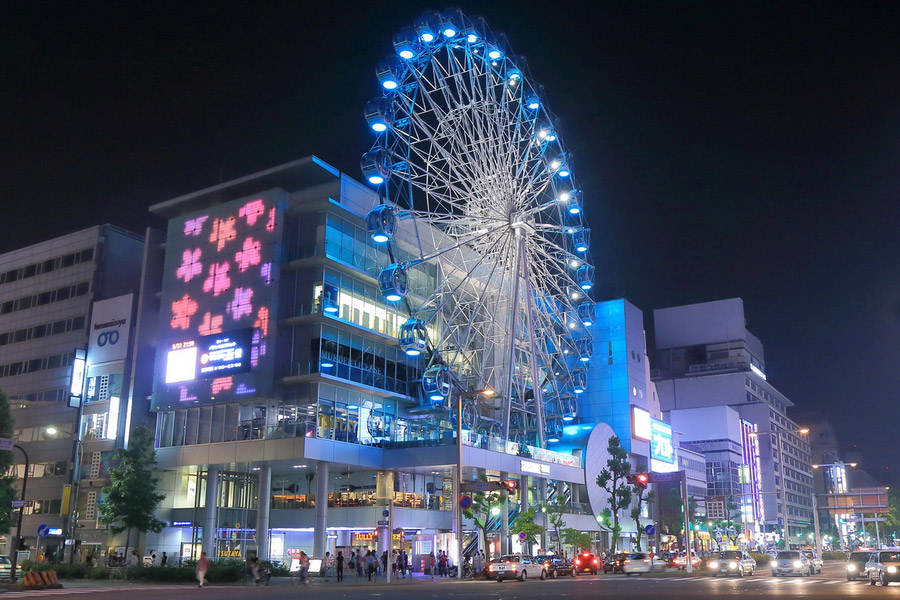
At the heart of Nagoya City lies downtown Sakae, teeming with culture and entertainment. A few of the landmarks we have already mentioned, like Nagoya TV Tower, Hisaya-odori Park, and Oasis 21, are located here. For example, Oasis 21 is a commercial complex with a distinct oval roof that sells everything from clothes to food and souvenirs. But there are more things to do in the city.
Discover Nagoya’s 3 Department Stores
Sakae’s famous three department stores are billed as “3M” as each starts with the letter “M”. Mitsukoshi Sakae has a lot of luxury shops and restaurants, but the eateries in the basement and top floors are less expensive. The Matsuzakaya department store is pretty much the same, but families will love it because it is kid-friendly. Maruei Galleria opened in 2022 on the site of the 400-year-old department store that closed in 2018.
Sunshine Sakae
The main attraction of this rather small mall with a few shops is a Ferris Wheel. Yet it can still cater to an ideal shopping experience for those looking for something purely Japanese, theme cafes, and even the SKE48 Theater performing on the 2nd floor of Sunshine Sakae.
Underground Streets in Nagoya
Not many countries have underground arcades for shopping, eating, and simply spending time. However, Japan is a king in that sense. Some believe the underground city concept, which spread across Japan, started in Nagoya.
Among the three arcades of this kind, Sakae Chika and Central Park are the most crowded. Hordes of people eat and shop there all the time. For a more traditional feel of Nagoya, the underground gallery of Mori no Chikagai is the right choice.
Enjoying Nightlife in Nagoya
Nagoya reveals a new side of its charm after the sun dips down the horizon. At night, Higashiyama Sky Tower, Sunshine Sakae Sky-Boat, and Midland Square Promenade transform into a beacon of light, offering vacationers exciting views of the city below.
Alternatively, you can escape the hustle and bustle of the city with a nighttime cruising adventure on the boat operated by Nogoya Cruising. Travel through the calm waters of the sea under the moonlight and take in the views of the city skyline and the glittering lights of the mainland.
Party animals or night owls should savor the atmosphere of Nishiki-3 Chrome, dubbed Kin-San by locals, the premier entertainment quarter in Nagoya. Whether you are looking for clubs, bars, ryotei (Japanese restaurants), or izakaya (Japanese pubs), you will find it all on its streets.
Finally, after a day of exploring Nagoya’s sights and sounds, relax with a nightcap at the café and bar Sozanso. Here, you can sip Japanese wines and whisky and unwind while reflecting on the nighttime adventures. Another reason to drop by Sozanso is that it is in the historic building designated as a Tangible Cultural Property of Japan.
Nagoya City Art Museum
Located next to the science museum, the Nagoya Art Museum contains a vast collection of works by Japanese and international artists, grouped under Ecole de Paris, Mexican Renaissance, Contemporary Art, and Local Artists. The museum displays many luminaries, including Marc Chagall, Amedeo Modigliani, Frida Kahlo, and Maurice Utrillo. From paintings and sculptures to multimedia installations, its exhibitions are a fun thing to explore.
What to Eat in Nagoya?
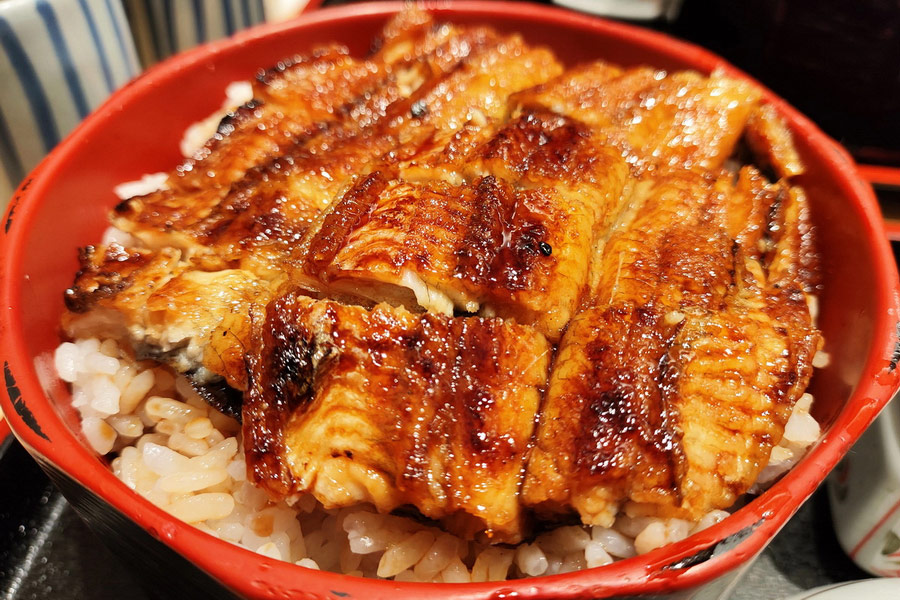
Nagoya boasts many places with great bars, restaurants, and local eats. But does the city have traditional Nagoya cuisine? The answer is YES! When hunger strikes, don't neglect the opportunity to partake in these culinary delights:
Kishimen
The first must-eat Nagoya food is kishimen - flat udon noodles. This soul food of Aichi Prefecture can be enjoyed anywhere in the city. Kishimen is made with soy broth, salt, miso, and sometimes curry. Locals prefer to eat it hot, topped with deep-fried tofu, bonito flakes, green onions, fish sausages, and seaweed.
Miso-Katsu
There are several variations of traditional Japanese katsu (cutlets), like tori and tonkatsu. The Nagoya version of tokatsu is miso-katsu, slices of panko-coated deep-fried pork cutlets poured over with salty miso sauce. It tastes crunchy on the outside and tender and juicy on the inside.
Tebasaki
Fried chicken wings are a favorite food for many. Japan has its own version of this dish called tebasaki. These wings are typically deep-fried without batter, seasoned with sweet and spicy soy, and piled high with white sesame seeds – Nagoya-style tebasaki.
Hitsu-mabushi
Another regional food to try in Nagoya is hitsu-mabushi. This is a must-try specialty dish of Nagoya, especially for unagi lovers. The grilled eel fillet with a crispy surface, served with thick and savory sauce and rice will get one’s mouth watering just by looking at it.
Moving Around in Nagoya
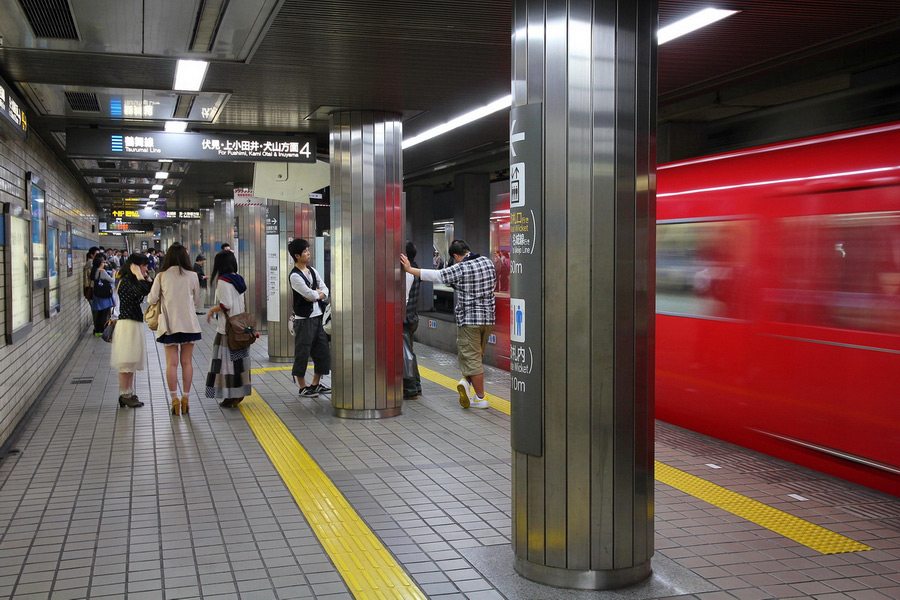
The best way to get around Nagoya is by subway. Major attractions, such as the Toyota Techno Museum, Nagoya Castle, Noritake Garden, and other tourist hangouts, can easily be reached by the Meguru Loop Bus lines. Bus and subway tickets are available at vending machines, ticket counters, and from bus drivers. For a hassle-free means of transportation from Tokyo to Nagoya, visitors will want to travel by the JR Tokaido Shinkansen, which takes less than 2 to 3 hours, depending on whether they are traveling by Nozomi, Hikari, or Kodama trains. Nagoya Railway is another affordable way to get around the most frequented districts. The prepaid IC cards, like Toica (run by JR) and Manaca (by the Meitetsu Railway and Nagoya Subway), work on nearly all trains, subways, and buses in the Greater Nagoya Region and other major cities of Japan. Nagoya is bike-friendly, with 219 cycling routes. Car rental is a good option for those traveling with children and lots of luggage.
Nagoya Subway

The Nagoya six-line subway system is not expensive and easy to navigate thanks to color-coded lines and bilingual maps. A 24-hour Subway Pass costs 760 yen. A metro-bus combination card, 1-Day Bus, and Subway Pass costs 870 yen. Other metro-bus combination tickets are the Shoryudo Nagoya Subway & Bus 1-Day Pass (620 yen) and the Donichi Eco Ticket (620 yen). The latter can only be used on weekends, national holidays, and the 8th of every month. Besides, all these passes cover the Meguru loop buses. Subways operate from 5 a.m. until 1:30 a.m. the next day. However, different lines operate on different schedules.
Nagoya Buses
As mentioned earlier, the Meguru Loop Bus is the most convenient way to get to many landmarks in Nagoya. A one-day ticket for unlimited rides costs 500 yen, while a single ride costs 210 yen. The buses operate regularly on weekdays and weekends, except Mondays when the museums are closed. Passengers can pay in cash to get a ticket, yet it’s better to use a prepaid card even from other regions like SUICA or ICOCA.
Note that you must press one of the stop buttons on the bus to indicate you want to get off and exit from the rear door.
Railway
The railway train operated by Meitetsu (Nagoya Railway) is the best option to reach the Nagoya suburbs and adjacent regions.
The line that connects Nagoya Station and Ise, including other cities in the Kansai Region, is called the Kintetsu Line. The same line will take travelers to Inuyama, Toyota, and Central Japan Airport.
Nagoya is connected with Tokyo, Kyoto, and Osaka with the following JR lines: Tokaido Shinkansen, Tokaido Main Line,
Chuo Line, Kansai Line, and Takayama Line.
Foreigners heading to the Expo Park should take the Linimo Line (maglev train) from Fujigaoka or Yakusa Stations.
Taxi
It’s best to travel by taxi when in a hurry, tired, or with a pile of baggage. Nagoya local taxis, such as Takara, Tsubame, MK Taxi, and Kintetsu, are easy to flag down on the road. They all accept Visa, Mastercard, JCB, American Express, and Diners Club International. However, we recommend considering Uber when traveling around Nagoya. The four-passenger taxi fare for the first two kilometers can range between 400 yen to 750 yen, depending on the route, and increases by around 100 yen every other 200-400 meters traveled. Keep in mind that many Japanese taxi or Uber drivers do not speak English. It's better to write down your destination’s address to prevent confusion.
Car Rental
Rental cars are easy to reserve, but driving through Nagoya is not recommended. The roads in Japan’s big cities typically have heavy traffic during peak hours, some signs might be confusing, and parking is expensive. A car can be rented online from Rental Cars, Kayak, and similar webpages. Daily rates start at $35 to $55, but you will have to pay for parking.
Nagoya by Bike
One of the convenient ways to get around Nagoya is by renting a bicycle. Cyclists can rent a Cariteco bike for 150 yen for the first 30 minutes and then 100 yen for each additional 30 minutes. Those planning on riding the two wheels longer can opt for the day pass, which costs 1,500 yen. The bike must be returned before 23:59. Carteco bike ports are scattered across many neighborhoods, including Nagoya Station and Sakae.


